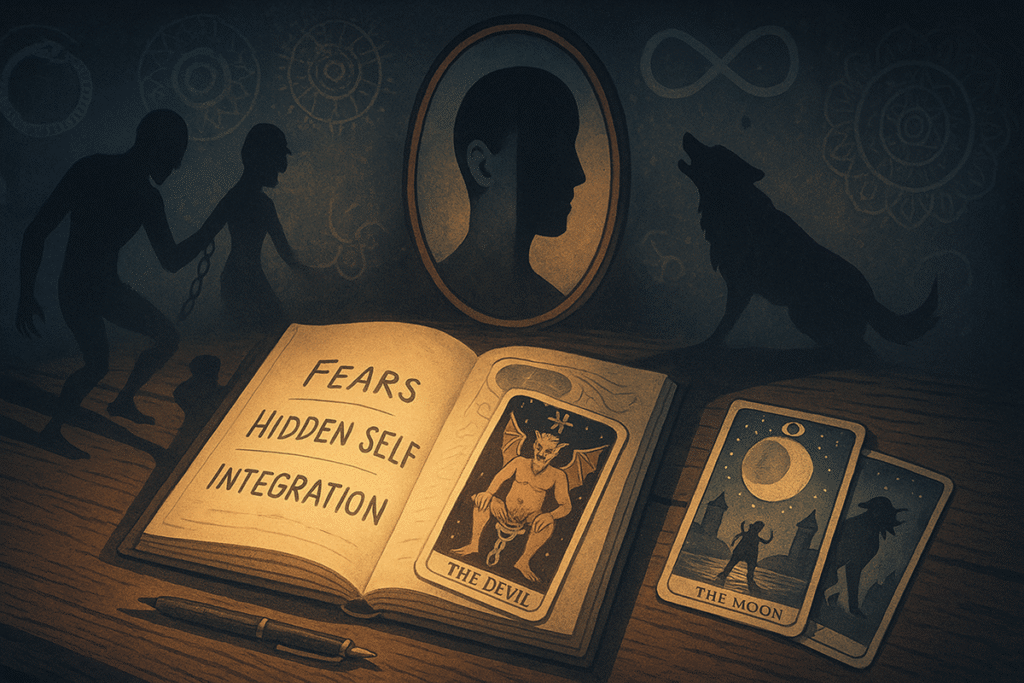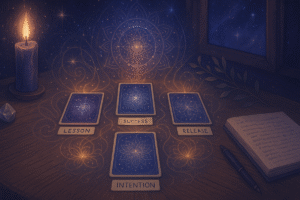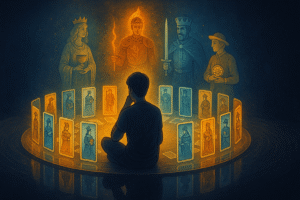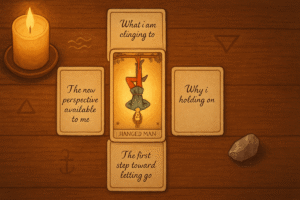Table of Contents
The concept of the shadow self might sound intimidating at first. I remember when I first encountered Carl Jung’s idea that we all have hidden aspects of our personality, parts we’ve pushed away or refuse to acknowledge. It felt overwhelming, perhaps even a little scary. But here’s what I’ve come to understand: working with your shadow isn’t about confronting some terrible monster within yourself. It’s about becoming more whole, more authentic, and ultimately more at peace with who you are.
Tarot offers a particularly gentle way to explore these hidden corners of our psyche. The cards serve as mirrors, reflecting back aspects of ourselves that we might not readily see or admit to. They don’t judge or condemn; they simply invite us to look, to question, and to explore with curiosity rather than fear.
Understanding Your Shadow Self
Jung described the shadow as the parts of our personality that we’ve deemed unacceptable, shameful, or simply incompatible with who we think we should be. These aren’t necessarily “bad” traits, though they can include things like anger, jealousy, or selfishness. Sometimes our shadow contains positive qualities we’ve suppressed because they didn’t fit our family’s expectations or society’s rules.
Maybe you grew up in a household where expressing anger wasn’t allowed, so you pushed that fiery part of yourself deep down. Perhaps you learned early that being too confident or taking up space made others uncomfortable, so you dimmed your natural radiance. Or maybe you’ve always been the “responsible one,” never allowing yourself to acknowledge your desire for spontaneity and freedom.
What makes shadow work so valuable is that these repressed parts don’t just disappear. They influence us from the unconscious, often showing up as projections onto others, unexplained emotional reactions, or patterns we can’t seem to break. When we shine a gentle light on these aspects through practices like tarot journaling, we can begin to integrate them more consciously.
The beauty of using tarot for this exploration is that the cards create a safe container for self examination. You’re not sitting across from a therapist being analyzed; you’re having a private conversation with yourself, using the imagery and symbolism of the cards as conversation starters.
Creating Your Shadow Work Space
Before diving into specific cards and practices, I think it’s important to establish the right environment for this kind of introspective work. Shadow exploration requires a sense of safety and non judgment. Choose a quiet space where you won’t be interrupted. Maybe light a candle or play soft music if that helps you feel more grounded.
Keep a dedicated journal for this practice. There’s something powerful about having a specific notebook that becomes a container for this inner work. Choose one that feels special to you, something that makes you want to write in it. I’ve found that the physical act of writing by hand often accesses different parts of our consciousness than typing on a computer.
Set an intention before you begin each session, but keep it gentle. Instead of “I’m going to uncover all my hidden flaws,” try something like “I’m open to understanding myself more deeply” or “I welcome all parts of myself with compassion.” The goal isn’t to fix yourself; it’s to know yourself more completely.
Remember that this work doesn’t have to be intense or dramatic. Some of the most profound insights come through quiet, gentle observation. You’re not excavating buried trauma here; you’re simply getting curious about the full spectrum of who you are.
Key Cards for Shadow Exploration
While any tarot card can potentially reveal shadow material, certain archetypes seem particularly suited to this kind of inner exploration. These cards often represent the parts of human experience that we tend to push away or struggle with.
The Devil card is perhaps the most obvious choice for shadow work, though it’s often misunderstood. In the context of self exploration, The Devil rarely represents evil or something to fear. Instead, it points to the places where we feel bound or limited by our own beliefs, habits, or desires. When this card appears in your shadow work, consider asking yourself: What patterns in my life feel compulsive or out of my control? Where do I give my power away? What desires do I judge in myself?
I find The Devil particularly interesting because it often reveals not just our shadows, but our relationship to pleasure, ambition, and material desires. Maybe there’s a part of you that craves luxury or success but you’ve been taught that such desires are shallow. Or perhaps you have a rebellious streak that you’ve never allowed yourself to express because it doesn’t fit your image of being “good.”
The Moon card invites exploration of our unconscious fears and illusions. This card speaks to the things that lurk in the darkness of our psyche, the fears we don’t want to name, the insecurities we pretend don’t exist. But The Moon also represents intuition and the mysterious depths of the psyche, suggesting that what seems scary in the darkness might actually hold wisdom.
When The Moon appears in your practice, you might ask: What am I most afraid others will discover about me? Where do I feel uncertain or confused about my own motivations? What fears have been guiding my choices without my conscious awareness?
The Tower often represents sudden revelations or the collapse of structures we’ve built to protect ourselves. In shadow work, this card might point to defense mechanisms that are no longer serving us, or beliefs about ourselves that are ready to be questioned. What image of myself am I clinging to that might not be entirely authentic? Where in my life am I avoiding necessary change?
Practical Journaling Techniques
The actual practice of shadow work with tarot is simpler than you might expect. Begin by shuffling your deck while holding the intention to explore a particular aspect of yourself. You might focus on a specific area of your life where you feel stuck, or simply remain open to whatever wants to emerge.
Draw one to three cards and place them face up in front of you. Before looking up any traditional meanings, spend time simply observing the images. What do you notice first? What emotions arise as you look at the cards? What aspects of the imagery do you find yourself resisting or drawn to?
Write down your immediate, uncensored reactions. This is crucial because our first responses often contain the most valuable information, before our analytical mind steps in to “correct” or sanitize our thoughts. You might write something like, “This figure looks so lonely and I immediately want to look away. That makes me think about how I avoid being alone with my own thoughts.”
Once you’ve captured your initial responses, begin to explore what the cards might be reflecting about your inner landscape. Here’s where the power of questioning becomes essential. Instead of seeking definitive answers, let yourself sit with uncertainty and curiosity.
If The Devil appears, for example, you might ask yourself: Where in my life do I feel trapped by my own choices? What would I do if I felt completely free? What desires do I judge as “bad” or inappropriate? How do I give my power away to others or to circumstances?
For The Moon, consider: What fears have been running in the background of my mind? Where do I trust others’ opinions more than my own intuition? What aspects of myself do I only show in private? When do I feel most uncertain about who I really am?
Embracing Integration and Self Acceptance
Perhaps the most important aspect of shadow work with tarot is what comes after the initial exploration and recognition. Once you’ve identified certain shadow aspects, the goal isn’t to eliminate them or judge them as wrong. Instead, the invitation is toward integration and acceptance.
This is where many people get stuck. They discover that they have capacity for jealousy, or selfishness, or anger, and they immediately want to fix or change these aspects. But shadow work is more about expanding your self awareness than about self improvement. When you can acknowledge all parts of yourself without judgment, you actually have more conscious choice about how you express these energies.
Maybe you discover through your tarot practice that you have a controlling side you’ve never wanted to admit. Instead of trying to eliminate this completely, you might explore how this part of you developed and what positive intention it originally served. Perhaps this controlling tendency helped you feel safe in an unpredictable childhood environment. Understanding this, you can appreciate this part of yourself while also choosing more consciously when and how to express it.
The integration process is gradual and requires patience with yourself. Some shadow aspects will be easier to accept than others. You might find that certain discoveries bring relief (finally understanding why you react strongly in specific situations), while others might trigger shame or resistance.
This is where the gentle, reflective approach becomes especially important. Remember that every human being has a shadow. The goal isn’t perfection; it’s wholeness. The most authentic, charismatic, and emotionally mature people aren’t those who have eliminated their flaws, but those who have made peace with their full humanity.
Building a Sustainable Practice
Shadow work with tarot isn’t something you need to do daily or even weekly. This kind of introspection can be intense, and it’s important to pace yourself. I’ve found that once or twice a month feels sustainable for most people, though you should trust your own rhythm.
Pay attention to your emotional state when deciding whether to engage in shadow work. If you’re going through a particularly stressful period, it might be better to focus on more supportive, nurturing practices. Shadow work is most effective when you’re feeling relatively stable and have emotional resources available for self exploration.
Keep track of patterns and insights that emerge over time. You might notice that certain themes keep appearing in your readings, or that your relationship to particular cards evolves as you do your inner work. This kind of tracking can reveal the deeper patterns of your psyche and help you recognize your growth over time.
Remember that this practice is ultimately about self compassion and understanding. If a session brings up difficult emotions or insights, be gentle with yourself afterward. Take a bath, go for a walk, or do something nurturing. Shadow work can be powerful and transformative, but it should never feel punishing or overwhelming.
The goal of working with your shadow self through tarot isn’t to become a different person, but to become more fully yourself. As you develop greater awareness and acceptance of all aspects of your personality, you’ll likely find that you feel more integrated, authentic, and at peace with who you are. And perhaps most importantly, you’ll develop greater compassion not just for yourself, but for the full spectrum of human experience that we all share.
Frequently Asked Questions
Do I need to be experienced with tarot to start shadow work journaling?
Not at all. Shadow work with tarot is more about honest self-reflection than perfect card interpretation. Beginners can absolutely start with simple one-card pulls and focus on their immediate emotional reactions to the imagery. What matters most is your willingness to be open and curious about what comes up, not your technical knowledge of traditional card meanings.
What if looking at certain cards makes me feel uncomfortable or scared?
That discomfort is actually valuable information. Strong reactions to specific cards often point directly to shadow material that’s ready to be explored. Take a deep breath, acknowledge the feeling without judgment, and gently ask yourself what specifically about the card triggers that response. You can always put the card away and return to it when you feel more grounded, or simply journal about why it makes you uncomfortable without forcing deeper exploration.
How often should I practice shadow work with tarot?
Once or twice a month is sustainable for most people, though you should trust your own rhythm. Shadow work can be emotionally intense, so it’s important not to overwhelm yourself. Pay attention to your emotional state and only engage when you’re feeling relatively stable and have the inner resources for self-reflection. This isn’t a daily practice; it’s deep work that deserves time and space between sessions.
Can shadow work bring up difficult emotions I’m not ready to handle?
Yes, which is why creating a safe, gentle approach is so important. If you’re currently experiencing significant mental health challenges, depression, or are in therapy for trauma, it’s wise to discuss shadow work with your therapist first. Always practice self-care after sessions, and remember that you can stop at any time. If insights feel overwhelming, take a break, reach out to a trusted friend, or seek professional support.







